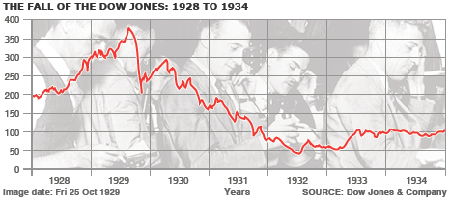The Dow Jones Industrial Average (DJIA) is one of America’s oldest stock market indexes and lists 30 companies that together are held representative of the health of the industrial stocks, and allows investors to chart the progress of individual stocks or groupings of stocks against a weighted average. The DJIA is assessed regularly and defunct or unrepresentative companies replaced with new entrants.
The DJIA owes its conception to Charles Henry Dow, who along with Edward Jones and Charles Bergstresser founded Dow Jones and Company, the parent company of the DJIA. Charles Dow founded the Wall Street Journal, a daily broadsheet published in New York from 1882. By 1884 Dow Jones was publishing a list of twelve railroad stocks and averaging their closing prices to indicate the overall health of the sector. That index is today known as the Dow Jones Transportation Index and is the direct predecessor of the DJIA.

By 1896 Charles Dow had recognized a need for industrial stocks to be listed, despite a general lack of faith in industrial stocks at the time. It was a bold move, not well understood by the market since most investors of the day were more interested in bonds from major railroad companies, the transport sector being seen as the engine of American economic growth. Industrial companies often struggled to raise funds so the creation of the DJIA was a welcome development for owners of industrial stock.
Dow’s original DJIA consisted of only 12 stocks, of which only one, General Electric, has survived the 110 years the DJIA has been published to remain in the index. The other eleven companies in the original DJIA included American Cotton Oil, American Sugar, American Tobacco, Chicago Gas, Distilling and Cattle Feeding, Laclede Gas, National Lead, Tennessee Coal and Iron, North American, U.S. Leather, and U.S. Rubber. Of these eleven, only Laclede Gas is still in business under its original name.
May 26th 1896 was the first date of publishing the DJIA by Dow Jones & Co, with the first average being rated at $40.94. A couple of months later the DJIA had dropped to just $28.48, its lowest result ever in the history of the DJIA. To the end of 1896 the Dow Jones Industrial Average maintained a fairly consistent average of $35-$36, although not as high as it opening average, this was still considered a good start to the DJIA since it reflected the general state of industrial stocks. Transportation however remained the darling of the stock market with the Dow Jone Transportation Average reaching $50 by years end, a disappointing result given the index contained 20 of America’s railroads.
It took ten years for the DJIA to reach its first milestone, closing at $100.25 on January 12th 1906, but it was nearly 20 years until $200 was reached. Between 1896 and 1916 several changes occurred with regular frequency to the DJIA, and by October 1916 very few of the original 12 stocks were left in the index, at the same time industrial stocks were more popular than transport stocks or bonds and it was time to revamp the index.
The published index on October 4th included 20 stocks, all of which were common stocks, and included new industrials such as American Telephone and Telegraph, Goodrich, Studebaker, Westinghouse, and Western Union. American Sugar, General Electric, and U.S. Rubber were the only companies still listed of the original 12 in the revamped index of 20 industrials.
In 1928, the Dow Jones Industrial Average was once again increased in the number of stocks covered, this time to 30, a number that has been maintained upto the present time. The 1920s were time of great development, often called the ‘roaring twenties’, a time when the index climbed to nealry $400 between 1927 and 1929, and sadly a time that resulted in the great crash of 1929, followed by the recession years of the 1930s. The DJIA closed at its second lowest point ever on July 8th 1932 at just $41.22, not far from the opening price in 1896, and a fall of nearly 90% from since the previous high of $381.17 back on September 3rd 1929.

A criticism of the DJIA has been the lack of relevance despite being the most visible stock market index, with commentators observing that the dependence on stock prices takes no account of the relative sizes or market capitalization of companies represented in the index. The DJIA is often compared with S&P 500, an index that is adjusted by market value rather than simply price weighted.
Strangely, the Dow Jones Industrial Index has never been seen to represent highs or lows in popular culture, with Kennedy’s assassination, the Arab Oil embargo, and the first Iraq war seeing bullish rallying of the index, and by contrast the moon landing coming in the midst of a bear market and another record drop in the DJIA. Significant closing milestones of the period also saw great celebrations in the NYSE and at Dow Jones with the index reaching 1,000 on November 14th 1972, and then 2,000 on January 8th 1987. By October 19th of 1987, a day known as Black Monday, the DJIa experienced its worst drop ever, falling 22.6 percent.
By July 2007 the DJIA hit 14,000 on two decades of economic growth and financial market bullishness, but by 2008-2009, in the midst of the global financial crisis this had fallen to a little over 8000, with many analysts expecting the index to find a new equilibrium below 8,000 by mid 2009.

As an interesting aside, Ford Motor Co has never been listed in the Dow Jones Industrial Average, whereas General Motors and Chrysler have been, and in 2009 Ford was the only one of the big three American motor companies expected to survive the economic crisis whilst GM and Chrysler were both expected to file bankruptcy proceedings despite multi-billion dollar stimulus from the US government.